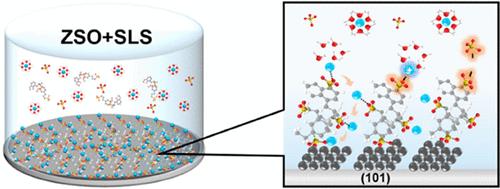Green Polymer Derived Multifunctional Layer Achieving Oriented Diffusion and Controllable Deposition of Zn2+ for Ultra-Durable Zinc-Ion Hybrid Supercapacitors
IF 8.2
2区 材料科学
Q1 MATERIALS SCIENCE, MULTIDISCIPLINARY
引用次数: 0
Abstract
Rampant dendrite growth and severe parasitic reactions at the electrode/electrolyte interface significantly limit the cycle life of aqueous zinc ion hybrid supercapacitors (ZHSCs). In this study, sodium lignosulfonate (SLS) as one green polymer was introduced into ZnSO4 electrolyte to construct a multifunctional layer on the surface of Zn plates. Experimental analyses and theoretical calculations show that the presence of the SLS layer, rich in oxygen-containing functional groups (−SO3–), can not only modulate the structure of the electric double layer (EDL) to suppress interfacial side reactions caused by free H2O and SO42–, but also promote (101)-oriented deposition by selectively controlling the deposition behavior of Zn2+ through specific adsorption on different crystalline surfaces. The optimized electrolyte allows stable Zn//Zn symmetric cells to achieve a cumulative plating capacity exceeding 4 Ah cm–2 at a high areal capacity of 5 mAh cm–2, and stable cycling for more than 1000 cycles with an excellent average Coulombic efficiency of 99.34% in Zn//Cu asymmetric cells. The Zn//AC ZHSC exhibits ultralong cycling stability of over 40,000 cycles in the optimized electrolyte, with a capacity decay rate as low as 0.000285% per cycle.

绿色聚合物衍生多功能层实现超耐用锌离子混合超级电容器中Zn2+的定向扩散和可控沉积
锌离子混合超级电容器的枝晶生长猖獗,电极/电解质界面寄生反应严重,严重限制了锌离子混合超级电容器的循环寿命。本研究将木质素磺酸钠(SLS)作为一种绿色聚合物引入到ZnSO4电解质中,在锌板表面构建多功能层。实验分析和理论计算表明,富含含氧官能团(−SO3 -)的SLS层的存在,不仅可以调节双电层(EDL)的结构,抑制游离H2O和SO42 -引起的界面副反应,还可以通过在不同晶体表面的特异性吸附,选择性地控制Zn2+的沉积行为,促进(101)取向沉积。优化后的电解液可使Zn/ Zn对称电池在5 mAh cm-2的高面容量下实现超过4 Ah cm-2的累计镀容量,并在Zn/ Cu不对称电池中稳定循环1000次以上,平均库仑效率达到99.34%。在优化的电解液中,Zn//AC ZHSC具有超过40,000次循环的超长循环稳定性,每循环的容量衰减率低至0.000285%。
本文章由计算机程序翻译,如有差异,请以英文原文为准。
求助全文
约1分钟内获得全文
求助全文
来源期刊

ACS Applied Materials & Interfaces
工程技术-材料科学:综合
CiteScore
16.00
自引率
6.30%
发文量
4978
审稿时长
1.8 months
期刊介绍:
ACS Applied Materials & Interfaces is a leading interdisciplinary journal that brings together chemists, engineers, physicists, and biologists to explore the development and utilization of newly-discovered materials and interfacial processes for specific applications. Our journal has experienced remarkable growth since its establishment in 2009, both in terms of the number of articles published and the impact of the research showcased. We are proud to foster a truly global community, with the majority of published articles originating from outside the United States, reflecting the rapid growth of applied research worldwide.
 求助内容:
求助内容: 应助结果提醒方式:
应助结果提醒方式:


